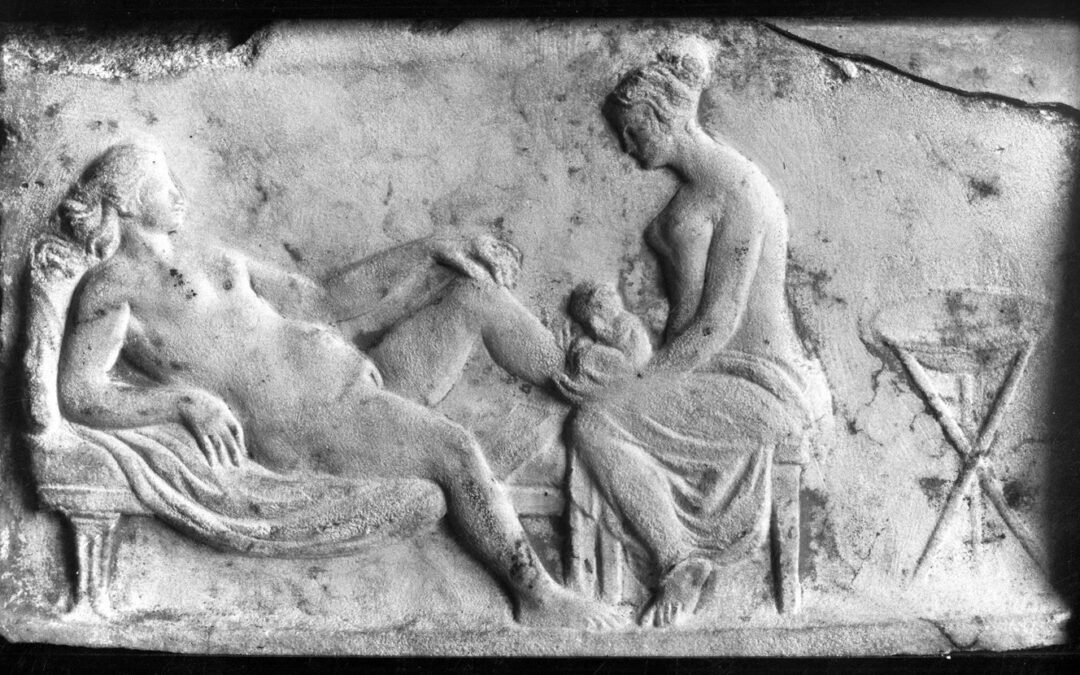This blog was written by Dr Giacomo Savani, an expert in Roman baths and ancient senses, and a recent intern looking at gender histories in the Bibliography of British and Irish History (BBIH). A version of this text was posted on the Women’s History Network blog in September 2023.
According to a funeral inscription from Rome dating to the first century CE, baths, wine, and sex are among the pleasures that vitam faciunt—‘make life worth living’. This brief text, alongside many other epigraphic and literary sources from all over the Roman world, demonstrates the genuine appreciation of baths and bathing shared by people of different ages, gender, and cultural and social backgrounds. Bathing took place in many forms and settings and responded to different needs and expectations. In this post, I address the role of gender in ancient bathing, focusing on the experience of unwell women and their long pilgrimages to find a cure.
By the first century BCE, baths and spas had become important healing spaces for the lower and upper classes alike. In his Natural History, a vast encyclopaedic work written in the second half of the first century CE, Pliny the Elder enthusiastically claims that ‘everywhere in many lands gush forth beneficent waters, here cold, there hot, there both’. Health tourists would flock to famous thermal springs all over the empire, like Baiae near Naples, Lagadas near Thessaloniki, and Bath in England. Many of these sites became the focus of religious complexes dedicated to healing gods like Diana, Hercules, Minera, Apollo, and, especially in the eastern regions of the empire, the god of medicine, Asclepius.
The medical literature of the first and second centuries CE contains several references to the use of normal and mineral water to regulate the body’s internal balance. Soranus of Ephesus, the author of the only surviving ancient treatise on gynaecology, believed in the curative properties of water, advising women to bathe to calm their minds in preparation for labour. He also recommended bathing for specific conditions such as lactation insufficiency and painful menstruation, demonstrating a nuanced understanding of the gender-specific benefits of water. Moreover, he prescribed swimming in the sea, bathing in mineral waters, and prolonged travelling for severe chronic conditions.
Frustratingly, Soranus never describes his female patients’ experience in a bathhouse (where women spent as much time as men) or any other bathing location. Indeed, we are left with the bare description of his prescriptions, with little or no evidence of the patients’ emotional responses. This distorted, doctor-focused picture can be mitigated by looking at contemporary inscriptions from spas associated with healing sanctuaries. Interestingly, epigraphic evidence from the Western Provinces suggests that it was more common for women than men to travel long distances to visit certain spas, sometimes preferring sites further afield to closer destinations. For instance, Iulia Tiberina travelled over 770 km from Chester to find a cure at Aachen, an important spa and sanctuary on the river Rhine. The reasons for her incredibly long journey cannot be ascertained, especially considering how much easier it would have been for her to visit Bath. Still, maybe she suffered from a condition that only the water of Aachen could heal.
Women that resorted to these extreme measures were likely in a state of prostration caused by their prolonged illness. They might have seen these healing trips as their last chance to find a cure. Their hopes were closely tied to their religious beliefs, which played a significant role in ancient healing practices, particularly those involving water. This complex emotional landscape shaped their experiences of the faraway spa or seaside location they travelled to. Because the sea was considered a hybrid space between the worlds of the living, the dead, and the gods, voluntarily plunging into the waves must have been especially unsettling.
You can use the Bibliography of British and Irish History (BBIH) to learn more about gender and bathing across different times and places. Useful starting points are this recent article on Roman Bath by Eleri H. Cousins and this article on women’s experience of Bath in the early modern period by Amanda E. Herbert. You can find a discussion on Iulia Tiberina’s inscription in Grünewald, M. 2017: ‘Roman Healing Pilgrimage North of the Alps’, in T. M. Kristensen and W. Friese (eds), Excavating Pilgrimage. Archaeological Approaches to Sacred Travel and Movement in the Ancient World, London, pp. 130–51. The translation of Pliny’s text (Nat. Hist. 31.2) is by W. H. S. Jones, Pliny. Natural History. Volume VIII: Books 28–32, (Cambridge, MA, 1963), at p. 381.
Header image: Roman relief carving of a midwife attending a woman giving birth, second century CE. In his treatise, Soranus advises women to bathe to calm their minds in preparation for labour. Credit: Wellcome Collection. Licence: Attribution 4.0 International (CC BY 4.0).

Twitter/X: https://twitter.com/GiacomoSavani
Work: https://www.st-andrews.ac.uk/classics/people/gs245/
ORCID: https://orcid.org/0000-0002-8076-9535

